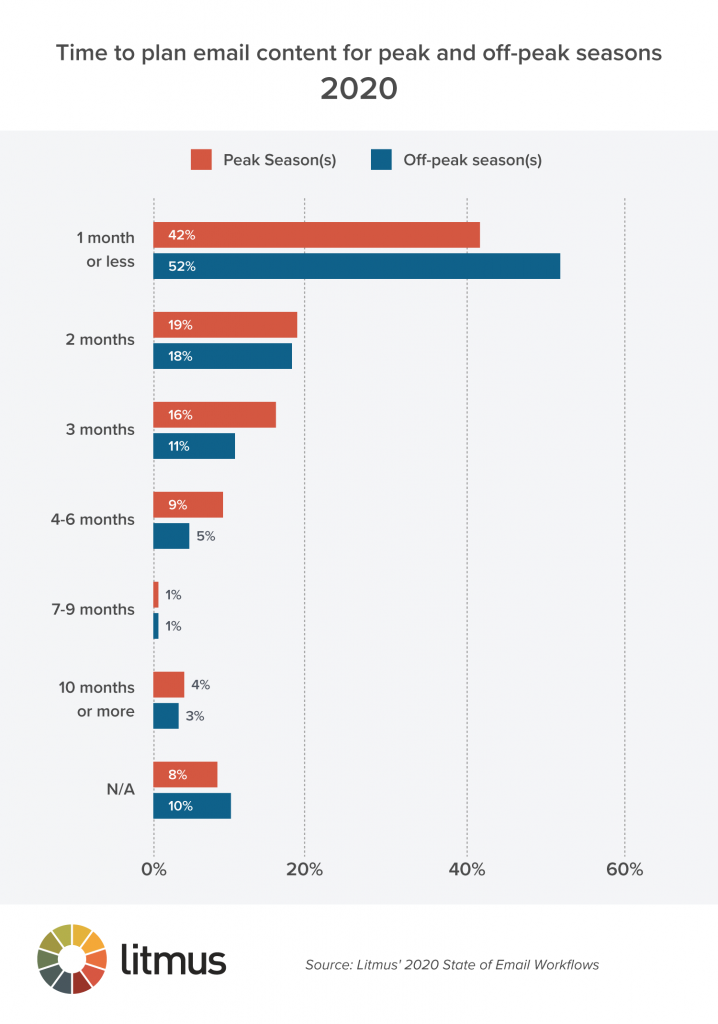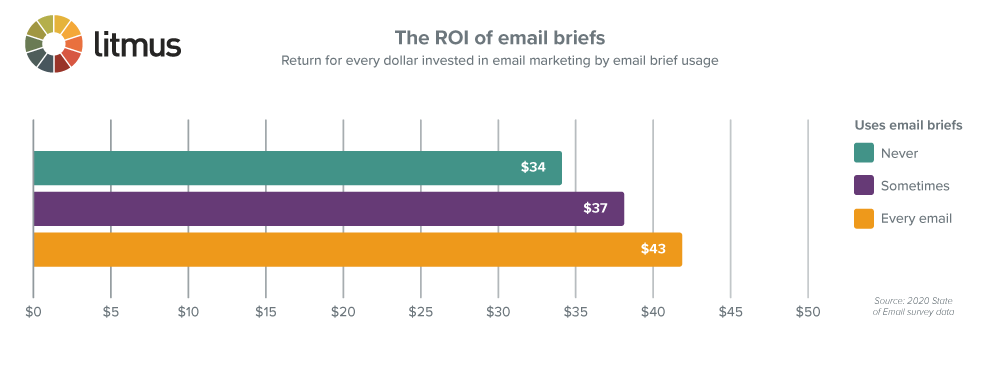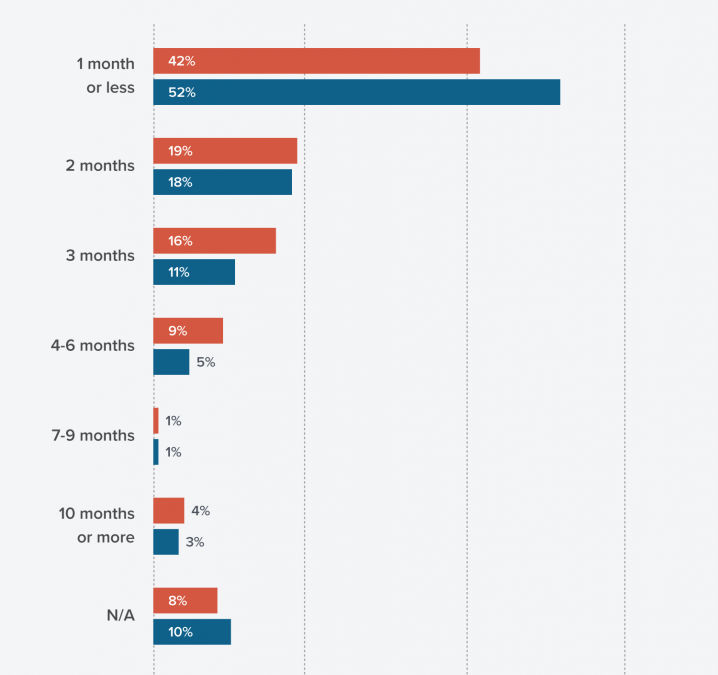When Ferris Bueller said, “Life moves pretty fast,” he wasn’t lying. The weeks and months have a way of peeling away faster than you realize, and before you know it, the end-of-year holiday frenzy will be upon us.
We’re always proponents of planning, but the BFCM era (that’s Black Friday and Cyber Monday) is extra essential to get right. The last quarter of the year historically makes up at least a third of annual sales in some industries, and there are many celebrations to be mindful of.
Brands seem to kick off their sales earlier and earlier each year. So here’s your friendly reminder that it’s time to start thinking about your holiday email planning. You’ll thank yourself later—we promise.
Keep reading to learn:
When do marketing teams start holiday email planning?
If you hadn’t given much thought to your year-end email strategy before today, you aren’t alone. Our 2020 State of Email Workflows report found that 45% of teams do their peak season planning a month or less in advance.

Thankfully, most teams are at least aware of what’s on the horizon since 60% of email teams use a year-round content calendar, and 15% use one at least during peak seasons.
To make the process as peaceful (and successful) as possible, we suggest you start strategizing your holiday emails at least four months in advance, like 10% of teams currently do. They also see the highest ROI, 64% more than the one-month-or-less planners.
Jodie Coher, marketing strategist at JAC Media, recommends kicking off your holiday email planning after the 4th of July. She shares:
 “By waiting until mid-July to plan, create, and test holiday emails, it allows everyone in the organization to begin looking toward the end-of-the-year sales. This timing still allows a few months to create an organized plan around customer campaigns and any holiday sales we may want to offer. It gives enough time for approvals and big picture planning without overthinking or appearing improvised.”
“By waiting until mid-July to plan, create, and test holiday emails, it allows everyone in the organization to begin looking toward the end-of-the-year sales. This timing still allows a few months to create an organized plan around customer campaigns and any holiday sales we may want to offer. It gives enough time for approvals and big picture planning without overthinking or appearing improvised.”
Why you need to prep holiday emails now to set yourself up for success (and balance)
Email marketers have to think on their feet, and you never know when there could be an update that throws a curveball in your strategy. Ivana Simovic, Senior Marketing Manager at Knix, said of the challenge of holiday marketing:
 “We have a plan, a backup plan, and a backup plan to our backup plan in the event that things go haywire.”
“We have a plan, a backup plan, and a backup plan to our backup plan in the event that things go haywire.”
Since you should expect the unexpected, it’s best to get a head start. Here’s why you should start your holiday email planning now.
Half of teams need two weeks or more to complete an email
The time it takes an email team to create an email is split down the middle around the two week mark. For 42% of teams in 2020, they only needed a week or two to produce a single email. The other 52% of teams spend two weeks or more per message. If you want to avoid a hectic scramble to get your emails produced in time, make sure you allot enough time based on your typical production runway.
The number of people involved in the process is also swelling. When we asked teams which departments are involved in reviewing and approving an email, at least a quarter of respondents indicated that the marketing, executive, sales, and legal teams play a role.

Thankfully, nearly half of email marketers think their approval process is “just right.” The second-largest response, though, was that the current approval process was too burdensome. If you have a few holiday email campaigns to manage, then the time you need to approve everything can start to wrack up.
You need to be ready to track more than just opens
Email marketing is so much more than the inbox—it’s a testing ground to learn about customers and break down channel boundaries. Since you shouldn’t create emails in a silo, now is the time to start collaborating across teams to set holiday marketing goals.
Sid Bharath, CEO and Founder of Broca, shared the importance of cross-channel collaboration:
 “There are dozens of pieces to plan out, like our ads, social media, landing pages, etc., and email is one of those pieces. So don’t look at email as a separate thing. It needs to fit in the overall marketing strategy, and the questions around timelines will stem from there.”
“There are dozens of pieces to plan out, like our ads, social media, landing pages, etc., and email is one of those pieces. So don’t look at email as a separate thing. It needs to fit in the overall marketing strategy, and the questions around timelines will stem from there.”
There’s also the tricky little Apple Mail Privacy Protection detail you’ll need to contend with starting in 2021. Since you might not have as much insight into open rates this fall for Apple Mail users, you need to start choosing your metrics and strategy carefully.
Warming up your IP before increased send volume protects deliverability
The end of the year is busy for everyone, and your email program is no different. If you plan on boosting your email volume during the holidays, you should start thinking about deliverability now.
If you were to suddenly start sending more emails than normal, you may trigger spam filters and harm your deliverability. To avoid this, make sure your IP is warmed up with a gradual increase before the holiday rush sets in.
Unique emails or automations take time to develop
Yes, holiday emails can be an important sales driver. But they’re also a time when you can take a lighthearted or innovative approach to marketing. Perhaps you want to coordinate a company-wide video message thanking customers for another great year. Or you want to perfect a few funny emails to end the year on a positive note. Maybe you want to give some fun interactivity or personalization a try. And if you have many holiday emails to create, you might want to create modular designs.
No matter what you want to experiment with, you’ll have more time to get a new tactic right if you start now.
 Petra Odak, Chief Marketing Officer at Better Proposals, is also a fan of testing the waters before the main event. She shared that:
Petra Odak, Chief Marketing Officer at Better Proposals, is also a fan of testing the waters before the main event. She shared that:
“We usually send one email per week about two months in advance before the holidays start. This gives enough time to inform everyone, and the frequency ensures we’re not spammy. Also, there is enough time to test everything, so we don’t make any rash decisions in our last few emails for the year.”
You deserve to have a (more) relaxing holiday break
Whether you celebrate a year-end holiday or just celebrate the end of the year, you deserve to have as relaxed a time as possible. Getting the kinks in your holiday campaigns worked out now reduces last-minute changes and scrambles. In turn, you’ll feel calmer when it’s time to hit send and maybe even enjoy a little time off.
How to get ahead of schedule this year
Can you feel it? This will be the year you get ahead of holiday email planning, and we’re here to help. This post is the first in a series about holiday email marketing, and there are plenty of best practices and examples in the works.
Until then, here are our tips to get your holiday email wheels in motion.
Choose your holidays
There’s no shortage of year-end events to choose from, ranging from the behemoth Black Friday/Cyber Monday to Single’s Day or Green Monday. However, since you can’t accommodate them all, it’s best to choose a few that make the most sense for your business and audience.
Here’s what’s coming up this year:
Email marketing holidays 2021
- Early November: “Black November” or Black Fridays in November campaigns
- November 11th: Single’s Day
- November 25th: Thanksgiving Day
- November 26th: Black Friday
- November 27th: Small Business Saturday
- November 28th: Advent begins
- November 28th: Hanukkah begins
- November 29th: Cyber Monday
- November 29th – December 2nd: Cyber Week (Cyber Monday through Thursday)
- November 30th: Giving Tuesday
- December 6th: Hanukkah ends
- December 13th: Green Monday
- December 18th: Super Saturday
- December 24th: Advent ends
- December 24th: Christmas Eve
- December 25th: Christmas Day
- December 26th: Day after Christmas
- December 26th: Boxing Day
- December 26th: Kwanzaa begins
- December 31st: New Year’s Eve
- January 1st: New Year’s Day
- January 1st: Kwanzaa ends
If you want to begin your email planning at least four months in advance, here’s when you’d need to start for each holiday:
Plan in July: Black November, Single’s Day, Thanksgiving
Plan in August: Black Friday, Cyber Monday, Small Business Saturday, Advent, Hanukkah, Giving Tuesday, Green Monday, Super Saturday
Plan in September: Christmas Eve and Day, Boxing Day, Kwanzaa, New Year’s Eve, New Year’s Day
Create a brief
The earlier you start planning your campaigns, the more time you have to work out all of the little details. Creating an email brief is essential for getting your holiday emails in order since it gets everyone on the same page now (and not when your file names end in newestfinalV2).
If you don’t start planning briefs now for peace of mind, then do it for the ROI. Our 2020 State of Email survey revealed that teams that use briefs for every email outperform other teams.

Try an agile workflow
Once you have a plan, it’s time to get to work. An agile email workflow focuses on micro-efficiencies and learning that make a big impact. If you download our agile email workflow guide now, you could have a new and improved process by the time BFCM rolls around.
Test, test, test
Not only should you create your holiday emails in advance, but you also need to test them, too. With automated pre-send checks in Litmus Test, you can preview your email in 90+ apps and devices. Now is the perfect time to start creating and testing your emails before the end-of-year scramble.
A little planning goes a long way
Thinking about all of the upcoming holidays and email campaigns can get overwhelming, fast. Starting your planning and development now ensures you only need to bite off a little bit of work at a time, though. If you want holiday email inspiration and best practices, keep a lookout for our upcoming post.
The post Holiday Email Planning: 4 Reasons to Start Now (and Breathe Easy) appeared first on Litmus.
![]()

